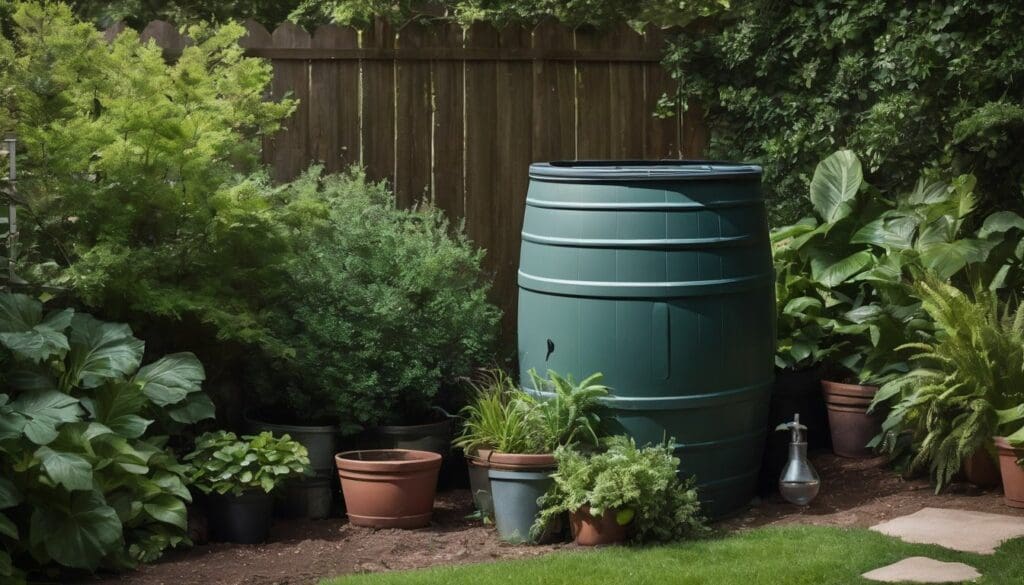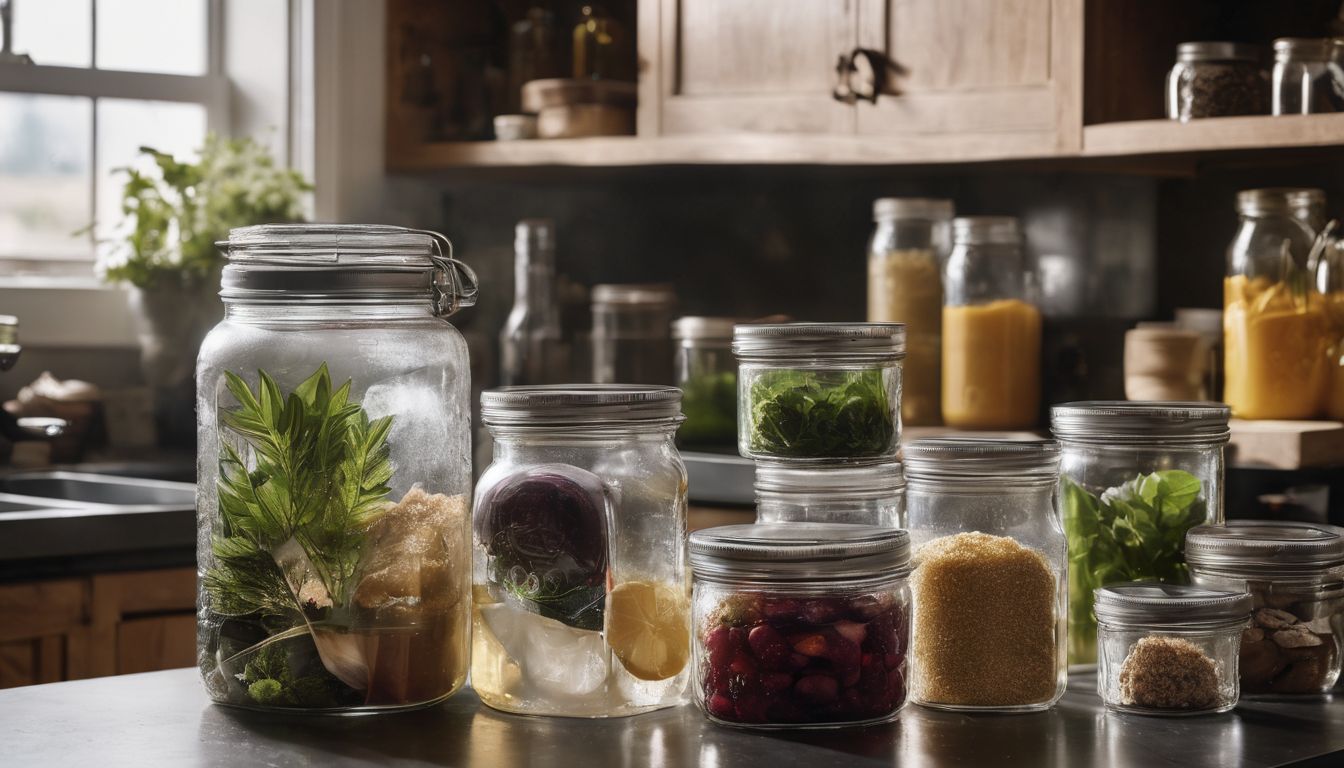Faced with water restrictions or high bills, many of us are seeking alternatives. Rainwater harvesting is an age-old practice that’s making a comeback. In this guide, we’ll show you how to start collecting and using rainwater at home, cutting costs and helping the planet.
Dive in for a greener tomorrow!
Key Takeaways
- Collecting rainwater reduces reliance on mains water, cuts costs and conserves drinkable supplies.
- Rain barrels and cisterns are common systems for storing harvested rainwater at home.
- Filtration is essential to make collected rainwater safe for household uses like watering gardens or cleaning.
- Using harvested rain can help prevent stormwater runoff pollution in rivers and lakes.
- Groundwater recharge through harvesting aids in sustainable management of local aquifers.
What is Rainwater Harvesting?
Rainwater harvesting involves collecting, storing and using rainwater for various purposes. It has been a common practice throughout history and continues to be an important method of sustainable water management.
Definition
Rainwater harvesting is the process of collecting, storing, and using rain that falls on roofs or other surfaces. It’s a sustainable water management practice that captures and stores rainwater for later use.
This method has become increasingly popular among those looking to reduce their environmental footprint, save money on water bills, and ensure an independent water supply in times of drought or shortages.
Capturing this precious resource involves funnelling it from surfaces where it lands—like rooftops—into storage containers such as barrels or tanks known as cisterns. The gathered water can then be purified and reused for various purposes such as gardening, flushing toilets, or even washing cars.
By integrating simple systems like DIY rainwater collection into urban home water systems or rural farm setups, individuals contribute to better stormwater management and the conservation of fresh drinkable water supplies.
History and continued relevance
Having understood the definition and methods of rainwater harvesting, it is important to acknowledge its history and continued relevance. Rainwater harvesting has been practised for centuries in various cultures around the world.
From ancient civilisations to modern sustainable living advocates, the practice of capturing and storing rainwater has always played a crucial role in ensuring water security during dry seasons.
Today, with growing concerns about water scarcity and environmental sustainability, rainwater harvesting continues to be an essential solution for conserving valuable drinking water supplies and reducing reliance on traditional water sources.
Benefits of Rainwater Harvesting
Rainwater harvesting offers cost savings, environmental benefits, and helps conserve drinkable water supply for future use. It is a sustainable and eco-friendly practice that contributes to water conservation efforts.
Cost savings
By harvesting rainwater, households can significantly reduce their water bills. The initial investment in a rainwater collection system, such as rain barrels or cisterns, can lead to substantial cost savings over time.
Furthermore, using harvested rainwater for activities such as watering gardens and washing vehicles eliminates the need to use piped water, further reducing utility costs.
Implementing a rainwater harvesting system allows individuals to take control of their water supply, reducing dependence on municipal resources and potentially lowering overall water usage.
Environmental benefits
By harvesting rainwater, you can significantly reduce your demand for mains water, thus conserving drinkable water supply and reducing strain on community resources. This practice also helps prevent stormwater runoff, which carries pollutants and contaminants into rivers and lakes, thereby protecting natural water sources.
Furthermore, using harvested rainwater for tasks such as watering plants and flushing toilets decreases the need for energy-intensive treated mains water.
Through rainwater harvesting at home, individuals can actively contribute to sustainable water practices while promoting green living in urban and rural areas. It’s a simple yet impactful way to support environmental conservation efforts and reduce reliance on traditional water sources.
Conserving drinkable water supply
Rainwater harvesting plays a crucial role in conserving drinkable water supply. By capturing rainwater, we reduce the demand on traditional water sources, such as reservoirs and underground aquifers.
This helps to alleviate pressure on municipal water systems and contributes to sustainable water management practices. Implementing rainwater harvesting at home not only ensures a more reliable supply of clean drinking water but also aids in mitigating the effects of drought by providing an alternative source for essential water needs.
To further support conservation efforts, using harvested rainwater for non-potable purposes like irrigation and household tasks can significantly decrease reliance on treated drinking water for activities that don’t require it.
Methods of Harvesting Rainwater
Surface runoff harvesting involves collecting rainwater from roofs, driveways, and other surfaces to redirect it to a storage system. Groundwater recharge involves allowing rainwater to percolate into the ground, replenishing aquifers and underground water sources.
Surface runoff harvesting
Surface runoff harvesting involves collecting rainwater that has flowed over the ground. This method is practical for both urban and rural settings, as it captures water from roofs, roads, and other impermeable surfaces.
Simple techniques include directing downspouts into rain barrels or cisterns to store water for various uses such as watering gardens or flushing toilets. Additionally, surface runoff harvesting promotes sustainability by reducing the strain on traditional water sources and helps mitigate flooding in urban areas.
Implementing surface runoff harvesting systems at home can significantly contribute to environmental conservation efforts. By harnessing this free resource, individuals can play a proactive role in sustainable water management while simultaneously reducing their eco-footprint.
Groundwater recharge
To recharge groundwater means to replenish the underground water sources by allowing rainwater to seep into the soil and reach aquifers. This process is crucial for maintaining a sustainable supply of clean drinking water and supporting ecosystems dependent on groundwater.
By capturing and directing rainwater into the ground through methods such as infiltration basins or permeable surfaces, we can help mitigate the effects of droughts and promote long-term water security.
Implementing practices that encourage groundwater recharge, including capturing rainwater from rooftops or using permeable paving materials in landscaping, can contribute significantly to preserving local water resources.
Choosing the Right Rainwater Collection System
When it comes to selecting a rainwater collection system, there are different options to consider such as rain barrels and cisterns. Each option has its own benefits and drawbacks, so it’s important to choose the right one based on your specific needs and circumstances.
Consider factors like space, budget, and intended use when making your decision.
Rain barrels
Rain barrels provide a simple and effective way to collect rainwater for various uses around your home. These barrels are typically placed under downpipes to capture runoff from the roof, preventing it from becoming surface runoff.
The collected water can then be used for watering plants, gardens, or even washing cars – reducing the demand on municipal water supplies. By incorporating rain barrels into your homestead water system, you’ll take a significant step towards sustainable living while also contributing to environmental conservation efforts.
Moreover, utilising rain barrels supports drought resistance and urban agriculture by providing an alternative source of water for eco-friendly gardening practices. When properly integrated with filtration systems, harvested rainwater can also be reused in greywater recycling and other non-potable applications, further decreasing reliance on conventional water sources.
Cisterns
Cisterns are large storage containers designed to hold rainwater. They come in various sizes and materials, such as concrete, plastic, or metal. Cisterns are an effective way to store a significant amount of rainwater for later use, making them ideal for households looking to reduce their reliance on mains water supply.
These systems work by collecting rainwater from rooftops through downpipes or gutters and directing it into the cistern. The collected water can then be used for purposes like watering gardens, flushing toilets, or other non-potable uses around the home.
With proper filtration and maintenance, cisterns offer an eco-friendly solution that supports sustainable water usage practices.
Purification and Use of Harvested Rainwater
After collecting rainwater, it is important to filter and purify it before using it for various purposes. Filtration removes debris and contaminants, ensuring that the water is safe for activities like watering plants or cleaning.
Importance of filtration
Filtration is vital in rainwater harvesting to remove debris, pollutants, and contaminants. This ensures that the collected water is safe for various uses, such as watering plants, cleaning, and even for drinking with proper treatment.
By investing in an effective filtration system, you can improve the quality of the harvested rainwater and reduce reliance on traditional water sources. It also contributes to sustainable living by promoting eco-friendly practices and reducing demand on municipal water supplies.
Proper filtration not only enhances the usability of harvested rainwater but also safeguards the environment from potential pollution. It helps maintain a clean and healthy ecosystem while supporting initiatives towards self-sufficiency and environmental conservation.
Potential uses for harvested rainwater
- Watering gardens and lawns to promote eco – friendly gardening practices and reduce reliance on municipal water sources.
- Flushing toilets, conserving drinkable water and reducing overall water consumption in the household.
- Cleaning outdoor spaces, such as washing cars or hosing down driveways, without tapping into the main water supply.
- Supplementary water source for livestock or pets, contributing to self – sufficiency and sustainability.
- Supplementing decorative fountains or ponds, supporting permaculture principles and maintaining ecosystem balance.
- Irrigating agricultural crops or establishing DIY irrigation systems to support sustainable farming practices.
Conclusion
In conclusion, rainwater harvesting offers numerous benefits for both the environment and your wallet. It provides a sustainable method of reducing water consumption and lowering utility costs.
By choosing the right collection system and implementing proper purification methods, you can make a positive impact on your local ecosystem while enjoying the practical advantages of reusing rainwater.
Start your journey towards eco-friendly living by exploring rainwater harvesting at home today!
FAQs
1. What is rainwater harvesting at home?
Rainwater harvesting at home involves collecting and storing rainwater for reusing in your garden or for other DIY water systems, helping you become more eco-friendly.
2. Can I use collected rainwater in my garden?
Absolutely! Reusing rainwater is perfect for ecofriendly gardening because it conserves tap water and provides your plants with natural moisture they love.
3. Do I need a big space to start harvesting rainwater?
Not at all! You can begin water collection with just a small setup that fits comfortably in any outdoor area of your home.
4. Is it hard to set up a system for collecting and storing rainwater?
It’s quite straightforward – with some basic materials and guidance, you can put together your own DIY water system to collect and store rainwater at home.





